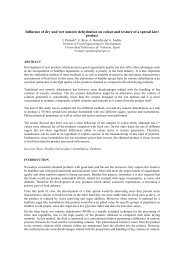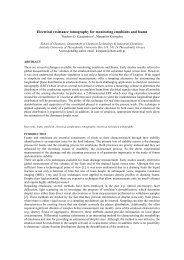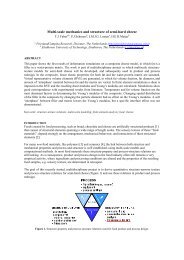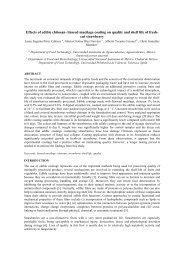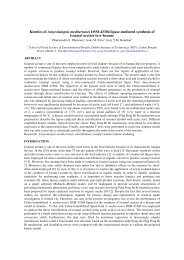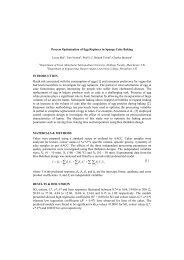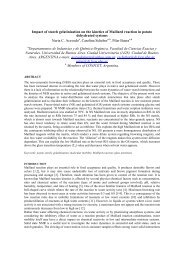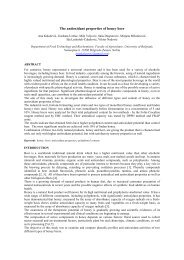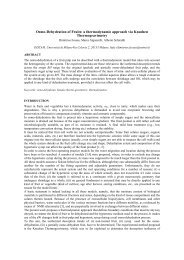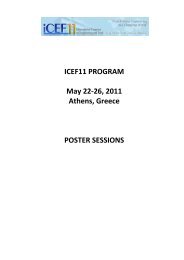The effect of UHT and VAT thermal processing - 11th International ...
The effect of UHT and VAT thermal processing - 11th International ...
The effect of UHT and VAT thermal processing - 11th International ...
Create successful ePaper yourself
Turn your PDF publications into a flip-book with our unique Google optimized e-Paper software.
Effect <strong>of</strong> heat treatment on gel strength<br />
Whey proteins have been demonstrated to participate in gel formation, while other studies have shown that<br />
heat treatment (conventional or <strong>UHT</strong>) <strong>of</strong> milk affects the rheological properties <strong>of</strong> yoghurt gel prepared from<br />
this milk [2]. However, a differential <strong>effect</strong> <strong>of</strong> <strong>VAT</strong> <strong>and</strong> <strong>UHT</strong> heat treatments on the gel strength <strong>of</strong> yoghurt<br />
made by the above <strong>processing</strong> systems was observed in this study. Gel strength measured by curd tension<br />
values ranged between 15 <strong>and</strong> 34.5 g for the <strong>UHT</strong> heat treatments <strong>and</strong> reached up to 85 g for the <strong>VAT</strong> heat<br />
treatments (Table 2). <strong>The</strong> strength <strong>of</strong> yoghurt gels prepared from <strong>UHT</strong> heat treatments was, thus, always<br />
lower than those prepared from <strong>VAT</strong> heat treatments. It is obvious, therefore, the following explanation: <strong>The</strong><br />
higher holding times applied in the <strong>UHT</strong> heat treatments seem to have a specific <strong>effect</strong> on some kind <strong>of</strong><br />
casein-whey protein-mineral interactions which in turn^ reduce the capacity <strong>of</strong> the network system to form<br />
high strength gels.<br />
Since beta-lactoglobulins compose 40-60% <strong>of</strong> the normal whey proteins, they should have a major<br />
contribution to gel strength. Investigators have noted that beta-lactoglobulin is the most important predictor<br />
<strong>of</strong> gel strength at pH 8.0 but not at pH 4.6 – 6.5. It is, also, well known that beta-lactoglobulins are the major<br />
source <strong>of</strong> sulfhydryl groups in whey proteins, so it might be possible that the sulfhydryl-disulfide interchange<br />
can make an important contribution to the formation <strong>of</strong> a gel matrix.<br />
Effect <strong>of</strong> heat denaturation on gelation<br />
A rough correlation between the extent <strong>of</strong> whey protein denaturation <strong>and</strong> gel strength was found for the <strong>VAT</strong><br />
heat treatments. For example, a heat treatment for 30 minutes at 66 0 C yielded only moderate denaturation<br />
<strong>and</strong> a considerably higher degree <strong>of</strong> the gel strength. No such correlation was observed for <strong>UHT</strong> heat<br />
treatments in relation to the gel strength. Although a progressive increase in protein denaturation with<br />
increasing process holding time at 149 0 C was found (Fig. 3), the strength <strong>of</strong> the yoghurt gel reached its<br />
maximum at 3.3 sec process holding time (Table 2). However, the degree <strong>of</strong> gel strength was found lower<br />
than the above at shorter or longer process holding times. It was, also, observed that the strength <strong>of</strong> yoghurt<br />
gels prepared from <strong>UHT</strong> heat treatments was lower than those prepared from <strong>VAT</strong> heat treatments regardless<br />
<strong>of</strong> the degree <strong>of</strong> denaturation.<br />
<strong>The</strong> lack <strong>of</strong> correlation between whey protein denaturation <strong>and</strong> degree <strong>of</strong> gel strength <strong>of</strong> yoghurts may reflect<br />
the lesser contribution <strong>of</strong> the <strong>UHT</strong> heat treatments to the matrix formation <strong>of</strong> the gel.<br />
<strong>The</strong> gelation <strong>of</strong> yoghurt is presumably a process which takes place in two stages. One corresponds to a slow<br />
unfolding (denaturation) <strong>of</strong> the proteins <strong>and</strong> the other to an aggregation (intermolecular disulfide)<br />
hydrophobia, hydrogen, <strong>and</strong> ionic bond reactions). During the second stage if it is sufficiently slow, a well<br />
ordered network may be formed due to intermolecular bind formation. If denaturation is too rapid <strong>and</strong>/or too<br />
extensive as with <strong>UHT</strong> heat treatments, there may be excessive local coagulation <strong>of</strong> protein <strong>and</strong> thus a<br />
weaker strength <strong>of</strong> gel results. <strong>The</strong> extent <strong>of</strong> denaturation <strong>of</strong> the whey proteins With progressive <strong>UHT</strong><br />
process holding time resulted in an increased strength <strong>of</strong> gels to a maximum point (149 0 C, 3.3 sec.) after<br />
which a decreased strength <strong>of</strong> gels started to occur. This could be a result <strong>of</strong> the sediment <strong>effect</strong> which is<br />
observed at the higher <strong>UHT</strong> heat treatments, which in turn could be the main factor for the reduction <strong>of</strong> gel<br />
strength in yoghurt.<br />
<strong>The</strong> respective degree lactogloglobulins at two temperatures <strong>and</strong> progressively longer process holding times<br />
as shown in Table 1 was ranged between 56 <strong>and</strong> 96%. <strong>The</strong> degree <strong>of</strong> gel strength for the <strong>VAT</strong> heat treatments<br />
increased progressively during the increased holding process times, while for the <strong>UHT</strong> heat treatments<br />
subsequently declined after a certain point, i.e. 149 0 C at 3.3 sec. According to de Witt <strong>and</strong> Swinkels (1980),<br />
the heat denaturation <strong>of</strong> a protein reflects the stability <strong>of</strong> the native structure. <strong>The</strong> increase in denaturation is<br />
correlated with an increase in yoghurt gel hardness for the <strong>VAT</strong> heat treatments, while denaturation <strong>of</strong> whey<br />
proteins was not associated with the degree <strong>of</strong> gel strength <strong>of</strong> yoghurt when <strong>UHT</strong> heat treatments were<br />
applied. <strong>The</strong>se indicate that the high temperatures <strong>of</strong> the <strong>UHT</strong> could possibly have some specific <strong>effect</strong>s on<br />
casein-whey protein or whey protein-mineral interactions which in turn may reduce the capacity o£ the<br />
casein-whey protein-mineral system to forma high strength gel. <strong>The</strong>se results could, also, be due to factors<br />
such as the sedimentation, an <strong>effect</strong> which can be due to interactions <strong>and</strong> co-precipitation <strong>of</strong> whey proteins,<br />
caseins <strong>and</strong> minerals, especially at the higher <strong>UHT</strong> heat treatments where it was observed to be increased.



